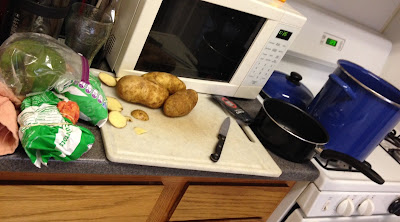Wintertime Shrub
Kimberly Gallagher of LearningHerbs.comWhen I think of the winter holidays, images of warmth and coziness and tasty treats always come to mind. Can’t you just smell the peppermint and cinnamon? Well, here’s a warming winter drink that will fill your kitchen with the smells of the holidays. It’s a Wintertime Cinnamon Shrub, and the recipe comes from a book called Homemade Root Beer and Soda Pop by Stephen Cresswell.
A shrub is a fruit drink with added vinegar or brandy to give it a bit of a tang. We’re going to add vinegar to this one, and that along with the cinnamon will help to warm up our insides when we drink our brew.
To make the shrub you will need:
½ cup raisins, coarsely chopped
3 cups dried apples, chopped
5 sticks cinnamon, each 3” long
2 tablespoons apple cider vinegar
1 cup sugar
3 to 4 quarts water
1/8 teaspoon granulated ale yeast (and ¼ cup lukewarm water)
(NOTE: We have a local "homebrew" store where we purchase a generic ale yeast. Any kind will do. It is a lot nicer than regular bread yeast. You can also find ale yeast online. I googled it and a lot of options came up)
Start by chopping your apples and raisins. Then put them in a large saucepan with 2 quarts of water, the cinnamon sticks, vinegar, and sugar. Bring the water to a boil, stirring until the sugar is dissolved. Simmer for 30 minutes, stirring occasionally. (This is the part where your kitchen gets filled with beautiful smells!)
Let’s pause here for a note about vinegar. You can use plain apple cider vinegar, but if you happen to have an herbally infused vinegar, that’s even better. I used dandelion infused vinegar that I made this spring. If I’d had some available I might have chosen burdock or fall dandelion root vinegar. They seem even better for this time of year, but really just use what you have.
Also, I did as this recipe said and added the vinegar to the simmering brew, but upon reflection, I think next time I will add it after the simmering is complete, since I think it will add more flavor at that time.
After 30 minutes, remove the pan from the heat and allow to cool, covered but with the lid ajar, for about 25 minutes.
While it’s cooling, prepare the yeast. I’ve been having mixed experiences with my yeast brews and recently have had the best success using the directions on the back of the yeast package, rather than the ones from the book. So I encourage you to read the instructions on the yeast you buy. Here’s what I ended up doing this time:
Put 4 ounces of lukewarm water (86-92 degrees) into a measuring cup. I did measure the temperature, since I’ve had such varied success.
Add 1/8 tsp. of yeast and do not stir. Let stand for 15 minutes, then stir gently.
Pour 2 quarts of cool water into a 1 gallon glass jug.
Strain the cooled, sweet liquid into the jug.
Check the temperature, then top off the jug, leaving about 2 inches of headspace for the yeast water.
Aim for an overall temperature of lukewarm (86-92 degrees).
If the brew and the yeast water are significantly different temperatures, add a little to the yeast water every 5 minutes until the temperatures are the same. (This is another precaution that may help your yeast to survive, since temperature shock can kill it.)
Add the yeast water to the brew, cap, and invert several times to mix.
Bottle, and store in a dark place. (I put mine in my pantry.)
Check the carbonation after 48 hours by opening and tasting the brew in one of your bottles. If it does not seem fizzy enough to you can let it sit for another day. I chose to let mine sit another 24 hours, and when I opened the bottle, it fizzed over the top and all over my floor. So, you might want to open yours over the sink.
Also, please know that whenever you’re making a carbonated beverage there is a risk that the bottles may explode if you leave them out of the refrigerator too long. So, don’t tuck them into too dark of place and forget about them, or leave one behind when you move them to the fridge. You will regret it. Heavy glass bottles with non-threaded tops are the least likely to explode, but you can get away with lighter glass or plastic bottles if you are diligent about checking the carbonation.
When you are satisfied with the level of carbonation of your drink, refrigerate your bottles to stop the action of yeast and enjoy your shrub over the next few days.




















